Short Answers
Q.1. A metallic loop is placed in a nonuniform magnetic field. Will an emf be induced in the loop?
If the flux through the loop does not vary, there will be no induced emf. Because the magnetic field is non-uniform and does not change with time, there will be no change in the magnetic flux through the loop. Hence, no emf will be induced in the loop.
Q.2. An inductor is connected to a battery through a switch. Explain why the emf induced in the inductor is much larger when the switch is opened as compared to the emf induced when the switch is closed.
When we close the switch, the current takes some time to grow in the circuit. Due to this growth of current, the flux increases; hence, an emf is induced. On the other hand, when we open the switch, there is no path for the current to flow; hence, it suddenly drops to zero. This rate of decrease of current is much greater than the rate of growth of current when the switch is closed. So, when the switch is opened, the induced emf is more.
Q.3. The coil of a moving-coil galvanometer keeps on oscillating for a long time if it is deflected and released. If the ends of the coil are connected together, the oscillation stops at once. Explain.
When the ends of the coil are not connected, the coil acts as an inductor in which oscillations persist until the current decays slowly. When these ends are connected, the coil forms a close loop; hence, there is inductance across the ends and the coil does not behave like an inductor. Therefore, all oscillations stop at once.
Q.4. A short magnet is moved along the axis of a conducting loop. Show that the loop repels the magnet if the magnet is approaching the loop and attracts the magnet if it is going away from the loop.
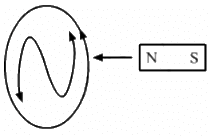
Consider the above situation in which a magnet is moved towards a conducting circular loop. The north pole of the magnet faces the loop. As the magnet comes closer to the loop, the magnetic field increases; hence, flux through the loop increases. According to Lenz's law, the direction of induced current is such that it opposes the magnetic field that has induced it. Thus, the induced current produces a magnetic field in the direction opposite to the original field; hence, the loop repels the magnet.
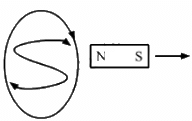
On the other hand, when the magnet is going away from the loop, the magnetic field decreases. Hence, flux through the loop decreases. According to Lenz's law, the induced current produces a magnetic field in the opposite direction of the original field; hence, the loop attracts the magnet.
Q.5. Two circular loops are placed coaxially but separated by a distance. A battery is suddenly connected to one of the loops establishing a current in it. Will there be a current induced in the other loop? If yes, when does the current start and when does it end? Do the loops attract each other or do they repel?
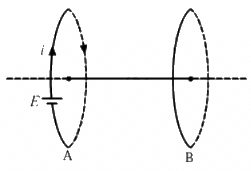
Consider loops A and B placed coaxially as shown above. Let the direction of the current in loop A be clockwise when the battery is connected to it. According to the right-hand screw rule, the direction of the magnetic field due to this current will be towards left, as seen from the side of B. Due to a sudden flux through loop B, a current will be induced in it. It will only be induced for a moment when the current suddenly jumps from zero to a constant value. After it has attained a constant value, there will be no induced current. Now, according to Lenz's law, the direction of the induced current in loop B will be such that it will oppose the magnetic field due to loop A. Hence, a current will be induced in anti-clockwise direction in loop B. The induced current will flow in loop B as soon as the current grows in loop A and will end when the current through loop A becomes zero. Because the directions of the currents in the loops are opposite, they will repel each other.
Q.6. The battery discussed in the previous question is suddenly disconnected. Is a current induced in the other loop? If yes, when does it start and when does it end? Do the loops attract each other or repel?
When the battery is suddenly disconnected, a current is induced in loop B due to a sudden change in the flux through it. It is only induced for a moment when the current suddenly falls to zero. There is no induced current after it has fallen to zero. According to Lenz's law, the induced current is such that it increases the decreasing magnetic field. So, if the current in loop A is in clockwise direction, the induced current in loop B will also be in clockwise direction. Hence, the two loops will attract each other.
Q.7. If the magnetic field outside a copper box is suddenly changed, what happens to the magnetic field inside the box? Such low-resistivity metals are used to form enclosures which shield objects inside them against varying magnetic fields.
The varying magnetic field induces eddy currents on the walls of the copper box. There is a magnetic field due to the induced eddy currents, that is in opposite direction. As copper has good conductivity, thus the magnetic field due to the eddy currents will be strong. The magnetic field induced due to eddy currents in the copper walls cancel the original magnetic field. Thus, magnetic field does not penetrate the enclosure made of copper. The magnetic field inside the box remains zero. This is how a copper box protects the inside material from varying magnetic fields.
Q.8. Metallic (nonferromagnetic) and nonmetallic particles in a solid waste may be separated as follows. The waste is allowed to slide down an incline over permanent magnets. The metallic particles slow down as compared to the nonmetallic ones and hence are separated. Discuss the role of eddy currents in the process.
When solid waste is allowed to slide over a permanent magnet, an emf is induced in metallic particles. This is because magnetic flux linked with the particles changes in this case. According to Lenz's law this induced emf opposes its cause i.e. downward motion along the inclined plane of the permanent magnet. On the other hand, non-metallic or insulating particles are free from such effects. As a result, the metallic particles slow down and hence get separated from the waste (or non-metallic particles).
Q.9. A pivoted aluminium bar falls much more slowly through a small region containing a magnetic field than a similar bar of an insulating material. Explain.
An aluminium bar falls slowly through a small region containing a magnetic field because of the induced eddy currents (or induced emf) in it. According to Lenz's law this induced eddy current oppose its cause (its motion). Hence, it slows down while falling through a region containing a magnetic field. On the other hand, non-metallic or insulating materials are free from such effects.
Q.10. A metallic bob A oscillates through the space between the poles of an electromagnet (See the figure). The oscillations are more quickly damped when the circuit is on, as compared to the case when the circuit is off. Explain.
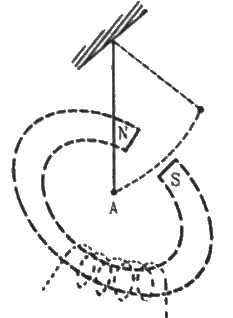
When the circuit is on, eddy currents are produced on the surface of the metallic bob. Due to these eddy currents, thermal energy is generated in it. This thermal energy comes at the cost of the kinetic energy of the bob; hence, oscillations are more quickly damped when the circuit is on compared to when the circuit is off.
Q.11. Two circular loops are placed with their centres separated by a fixed distance. How would you orient the loops to have (a) the largest mutual inductance (b) the smallest mutual inductance?
(a) For the largest mutual inductance, the two loops should be placed coaxially. In this case, flux through a loop due to another loop is the largest; hence, mutual inductance is the largest.
(b) For the smallest mutual inductance, the two loops should be placed such that their axes are perpendicular to each other. In this case, flux through a loop due to another loop is the smallest (zero); hence, mutual inductance is the smallest.
Q.12. Consider the self-inductance per unit length of a solenoid at its centre and that near its ends. Which of the two is greater?
Self-inductance per unit length of solenoid is given as,
L/l = μ0n2A
From the above equation we can see that, self inductance per unit length will depend on the permeability of free space (μ0) number of turns per unit length (n) and area of the cross-section of the solenoid (A). All the above factors are constant at the centre and near any end of the solenoid therefore self inductance at both the points will be same.
Q.13. Consider the energy density in a solenoid at its centre and that near its ends. Which of the two is greater?
In a solenoid energy is stored in the form of magnetic field. If a constant current is flowing from a solenoid then magnetic field inside the solenoid is uniform. Therefore, energy per unit volume (or energy density) in the magnetic field inside the solenoid is constant.
The energy per unit volume in the magnetic field is given as, μ = B/2μ0, where B is uniform magnetic field inside the solenoid.
Therefore, energy density all points inside a solenoid is same.
Multiple Choice Questions
Question for HC Verma Questions and Solutions: Chapter 38: Electromagnetic Induction- 1
Try yourself:A rod of length l rotates with a small but uniform angular velocity ω about its perpendicular bisector. A uniform magnetic field B exists parallel to the axis of rotation. The potential difference between the centre of the rod and an end is ______________
Explanation
Report a problem
Question for HC Verma Questions and Solutions: Chapter 38: Electromagnetic Induction- 1
Try yourself:A rod of length l rotates with a uniform angular velocity ω about its perpendicular bisector. A uniform magnetic field B exists parallel to the axis of rotation. The potential difference between the two ends of the rod is ___________ .
Explanation
Report a problem
Question for HC Verma Questions and Solutions: Chapter 38: Electromagnetic Induction- 1
Try yourself:Consider the situation shown in figure. If the switch is closed and after some time it is opened again, the closed loop will show ____________ .

Explanation
When the switch is closed, the current will flow in downward direction in part AB of the circuit nearest to the closed loop.
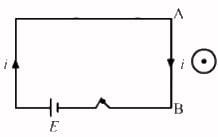
Due to current in wire AB, a magnetic field will be produced in the loop. This magnetic field due to increasing current will be the cause of the induced current in the closed loop. According to Lenz's law, the induced current is such that it opposes the increase in the magnetic field that induces it. So, the induced current will be in clockwise direction opposing the increase in the magnetic field in upward direction.
Similarly, when the circuit is opened, the current will suddenly fall in the circuit, leading to decrease in the magnetic field in the loop. Again, according to Lenz's law, the induced current is such that it opposes the decrease in the magnetic field. So, the induced current will be in anti-clockwise direction, opposing the decrease in the magnetic field in upward direction.
Report a problem
Question for HC Verma Questions and Solutions: Chapter 38: Electromagnetic Induction- 1
Try yourself:Consider the situation shown in figure. If the closed loop is completely enclosed in the circuit containing the switch, the closed loop will show ______ .
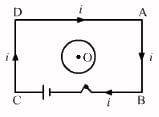
Explanation
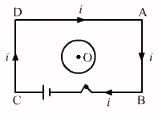
According to Lenz's law, the induced current in the loop will be such that it opposes the increase in the magnetic field due to current flow in the circuit. Therefore, the direction of the induced current when the switch is closed is anti-clockwise.
Similarly, when the switch is open, there is a sudden fall in the current, leading to decrease in the magnetic field at the centre of the loop. According to Lenz's law, the induced current in the loop is such that it opposes the decrease in the magnetic field. Therefore, the direction of the induced current when the switch is open is clockwise.
Report a problem
Question for HC Verma Questions and Solutions: Chapter 38: Electromagnetic Induction- 1
Try yourself:A bar magnet is released from rest along the axis of a very long, vertical copper tube. After some time the magnet ____________ .
Explanation
As the magnet is moving under gravity, the flux linked with the copper tube will change because of the motion of the magnet. This will produce eddy currents in the body of the copper tube. According to Lenz's law, these induced currents oppose the fall of the magnet. So, the magnet will experience a retarding force. This force will continuously increase with increasing velocity of the magnet till it becomes equal to the force of gravity. After this, the net force on the magnet will become zero. Hence, the magnet will attain a constant speed.
Report a problem
Question for HC Verma Questions and Solutions: Chapter 38: Electromagnetic Induction- 1
Try yourself:Figure shows a horizontal solenoid connected to a battery and a switch. A copper ring is placed on a frictionless track, the axis of the ring being along the axis of the solenoid. As the switch is closed, the ring will __________ .

Explanation
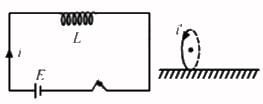
For the circuit,
E = -L(di/dt)
The current will increase in the solenoid, flowing in clockwise direction in the circuit. Due to this increased current, the flux linked with the copper ring with increase with time, causing an induced current. This induced current will oppose the cause producing it. Hence, the current in the copper ring will be in anticlockwise direction. Now, because the directions of currents in the solenoid and ring are opposite, the ring will be repelled and hence will move away from the solenoid.
Report a problem
Question for HC Verma Questions and Solutions: Chapter 38: Electromagnetic Induction- 1
Try yourself:Consider the following statements:-
(A) An emf can be induced by moving a conductor in a magnetic field.
(B) An emf can be induced by changing the magnetic field.
Explanation
Statement A is true, as an emf can be induced by moving a conductor with some velocity v in a magnetic field B. It is given by
e = Bvl
Statement B is true, as an emf can be induced by changing the magnetic field that causes the change in flux ϕ through a conductor or a loop. It is given by
e = 
Report a problem
Question for HC Verma Questions and Solutions: Chapter 38: Electromagnetic Induction- 1
Try yourself:Consider the situation shown in figure. The wire AB is slid on the fixed rails with a constant velocity. If the wire AB is replaced by a semicircular wire, the magnitude of the induced current will _____________ .
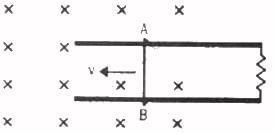
Explanation
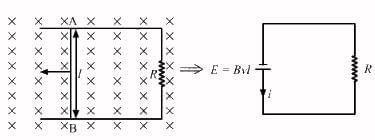
The induced emf across ends A and B is given by
E = Bvl
This induced emf will serve as a voltage source for the current to flow across resistor R, as shown in the figure. The direction of the current is given by Lenz's law and it is anticlockwise.
i = Bvl/R
If the wire is replaced by a semicircular wire, the induced current will remain the same, as it depends on the length of the wire and not on its shape (when B, v and R are kept constant).
Report a problem
Question for HC Verma Questions and Solutions: Chapter 38: Electromagnetic Induction- 1
Try yourself:Two circular loops of equal radii are placed coaxially at some separation. The first is cut and a battery is inserted in between to drive a current in it. The current changes slightly because of the variation in resistance with temperature. During this period, the two loops _______________ .
Explanation

Consider loops A and B placed coaxially as above. Let the direction of the current in loop A be clockwise when a battery is connected to it. According to the right-hand screw rule, the direction of the magnetic field due to this current will be towards the left. Now, the current through this loop will decrease with time due to an increase in resistance with temperature. So, the magnetic field due to this current will also decrease with time. This changing current will induce a current in loop B. Now, according to Lenz's law, the direction of the induced current in loop B will be such that it will oppose the decrease in the magnetic field due to loop A. Hence, current will be induced in a clockwise direction in loop B. Also, because the direction of the currents in the loops is the same, they will attract each other.
Report a problem
Question for HC Verma Questions and Solutions: Chapter 38: Electromagnetic Induction- 1
Try yourself:A small, conducting circular loop is placed inside a long solenoid carrying a current. The plane of the loop contains the axis of the solenoid. If the current in the solenoid is varied, the current induced in the loop is _______ .
Explanation
The magnetic field inside the solenoid is parallel to its axis. If the plane of the loop contains the axis of the solenoid, then the angle between the area vector of the circular loop and the magnetic field is zero. Thus, the flux through the circular loop is given by

Here,
B = Magnetic field due to the solenoid
A = Area of the circular loop
θ = Angle between the magnetic field and the area vector
Now, the induced emf is given by
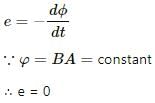
We can see that the induced emf does not depend on the varying current through the solenoid and is zero for constant flux through the loop. Because there is no induced emf, no current is induced in the loop.
Report a problem
Question for HC Verma Questions and Solutions: Chapter 38: Electromagnetic Induction- 1
Try yourself:A conducting square loop of side l and resistance R moves in its plane with a uniform velocity v perpendicular to one of its sides. A uniform and constant magnetic field Bexists along the perpendicular to the plane of the loop as shown in figure. The current induced in the loop is _____________ .
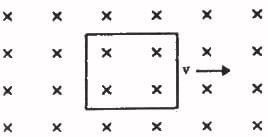
Explanation

Figure (a) shows the square loop moving in its plane with a uniform velocity v.
Figure (b) shows the equivalent circuit.
The induced emf across ends AB and CD is given by
E = Bvl
On applying KVL in the equivalent circuit, we get
E - E + iR = 0
⇒ i = 0
No current will be induced in the circuit due to zero potential difference between the closed ends.
Report a problem
*Multiple options can be correct
Question for HC Verma Questions and Solutions: Chapter 38: Electromagnetic Induction- 1
Try yourself:A bar magnet is moved along the axis of a copper ring placed far away from the magnet. Looking from the side of the magnet, an anticlockwise current is found to be induced in the ring. Which of the following may be true?
Explanation
It can be observed that the induced current is in anti-clockwise direction. So, the magnetic field induced in the copper ring is towards the observer.
According to Lenz's law, the current induced in a circuit due to a change in the magnetic flux is in such direction so as to oppose the change in flux.
Two cases are possible:-
(1) The magnetic flux is increasing in the direction from the observer to the circularcoil.
(2) The magnetic flux is decreasing in the direction from the coil to the observer.
So, from the above mentioned points, the following conclusions can be made:-
1. The south pole faces the ring and the magnet moves away from it.
2. The north pole faces the ring and the magnet moves towards it.
*Multiple options can be correct
Question for HC Verma Questions and Solutions: Chapter 38: Electromagnetic Induction- 1
Try yourself:A metal sheet is placed in front of a strong magnetic pole. A force is needed to ______________ .
Neglect any effect of paramagnetism, diamagnetism and gravity.
Explanation
The strong magnetic pole will attract the magnet, so a force is needed to hold the sheet there if the metal is magnetic.
If we move the metal sheet (magnetic or nonmagnetic) away from the pole, eddy currents are induced in the sheet. Because of eddy currents, thermal energy is produced in it. This energy comes at the cost of the kinetic energy of the plate; thus, the plate slows down. So, a force is needed to move the sheet away from the pole with uniform velocity.
Question for HC Verma Questions and Solutions: Chapter 38: Electromagnetic Induction- 1
Try yourself:A conducting loop is placed in a uniform magnetic field with its plane perpendicular to the field. An emf is induced in the loop if ___________.
Explanation
A conducting loop is placed in a uniform magnetic field with its plane perpendicular to the field. An emf is induced in the loop if it is rotated about its diameter.
Report a problem
*Multiple options can be correct
Question for HC Verma Questions and Solutions: Chapter 38: Electromagnetic Induction- 1
Try yourself:A constant current i is maintained in a solenoid. Which of the following quantities will increase if an iron rod is inserted in the solenoid along its axis?
Explanation
Iron rod has high permeability. When it is inserted inside a solenoid the magnetic field inside the solenoid increases. As magnetic field increases inside the solenoid thus the magnetic flux also increases. The Self-inductance (L) of the coil is directly proportional to the permeability of the material inside the solenoid. As the permeability inside the coil increases. Therefore, the self-inductance will also increase.
*Multiple options can be correct
Question for HC Verma Questions and Solutions: Chapter 38: Electromagnetic Induction- 1
Try yourself:Two solenoids have identical geometrical construction but one is made of thick wire and the other of thin wire. Which of the following quantities are different for the two solenoids?
Explanation
Because the solenoids are identical, their self-inductance will be the same.
Resistance of a wire is given by
R = p(l/A)
Here,
l = Length of the wire
A = Area of cross section of the wire
ρ = Resistivity of the wire
Because ρ and l are the same for both wires, the thick wire will have greater area of cross section and hence less resistance than the thin wire.

The time constant for a solenoid is given by

Thus, time constants of the solenoids would be different if one solenoid is connected to one battery and the other is connected to another battery.
Also, because the self-inductance of the solenoids is the same and the same current flows through them, the magnetic field energy given by 1/2Li2 will be the same.
Power dissipated as heat is given by
P = i2R
i is the same for both solenoids.
∴ Pthick < Pthin
Because the resistance of the coils are different, the rate of Joule heating will be different for the coils if the same current goes through them.
Question for HC Verma Questions and Solutions: Chapter 38: Electromagnetic Induction- 1
Try yourself:An LR circuit with a battery is connected at t = 0. Which of the following quantities is not zero just after the connection?
Explanation
At time t = 0, the current in the L-R circuit is zero. The magnetic field energy is given by U = (1/2)Li2, as the current is zero the magnetic field energy will also be zero. Thus, the power delivered by the battery will also be zero. As, the LR circuit is connected to the battery at t = 0, at this time the current is on the verge to start growing in the circuit. So, there will be an induced emf in the inductor at the same time to oppose this growing current.
Report a problem
Question for HC Verma Questions and Solutions: Chapter 38: Electromagnetic Induction- 1
Try yourself:A rod AB moves with a uniform velocity v in a uniform magnetic field as shown in figure.
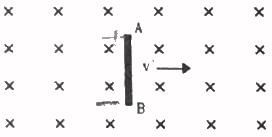
Explanation
Due to electromagnetic induction, emf e is induced across the ends of the rod. This induced emf is given by e = Bvl
The direction of this induced emf is from A to B, that is, A is at the higher potential and B is at the lower potential. This is because the magnetic field exerts a force equal to qvB on each free electron where q is -1.6 × 10-16C. The force is towards AB by Fleming's left-hand rule; hence, negatively charged electrons move towards the end B and get accumulated near it. So, a negative charge appears at B and a positive charge appears at A.
Report a problem
Question for HC Verma Questions and Solutions: Chapter 38: Electromagnetic Induction- 1
Try yourself:A conducting rod is moved with a constant velocity v in a magnetic field. A potential difference appears across the two ends ____.
Explanation
Report a problem
*Multiple options can be correct
Question for HC Verma Questions and Solutions: Chapter 38: Electromagnetic Induction- 1
Try yourself:L, C and R represent the physical quantities inductance, capacitance and resistance respectively. Which of the following combinations have dimensions of frequency?
*Multiple options can be correct
Question for HC Verma Questions and Solutions: Chapter 38: Electromagnetic Induction- 1
Try yourself:The switches in figure (a) and (b) are closed at t = 0 and reopened after a long time at t = t0.




















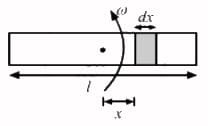

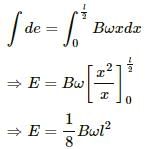


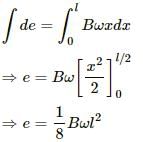



















 will have the dimensions of the frequency.
will have the dimensions of the frequency.




















